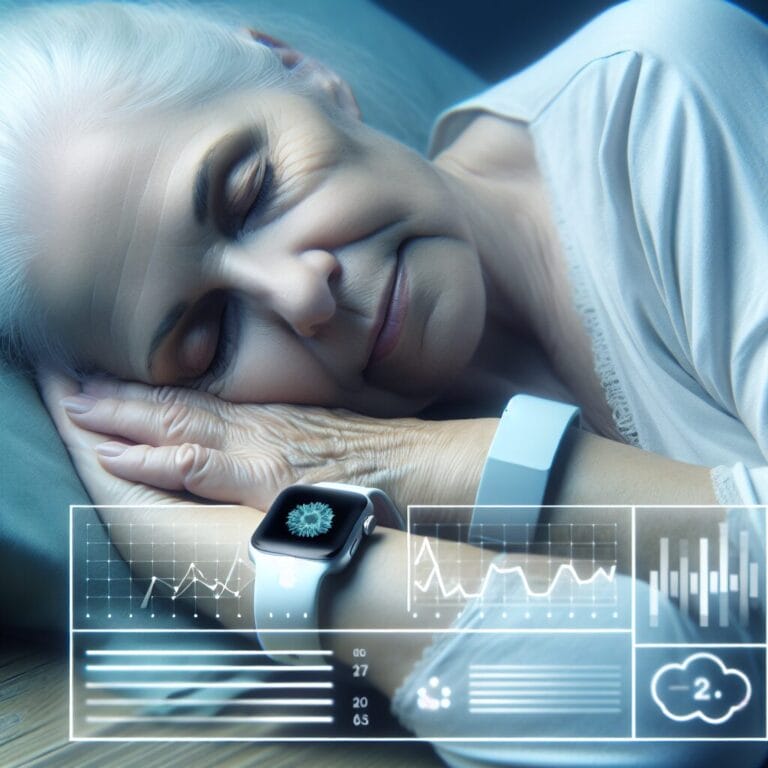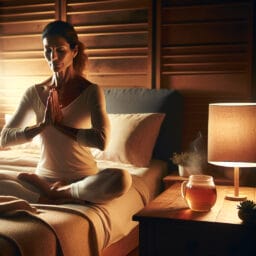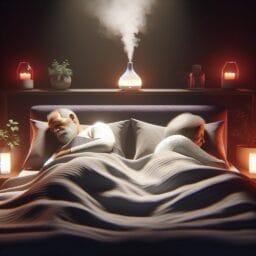
5 Technology-Driven Sleep Optimization Tips for the Elderly
Table of Contents
- Introduction
- Understanding Sleep Challenges in the Elderly
- Tip #1: Smart Mattresses and Sleep Trackers
- Tip #2: Wearable Sleep Devices
- Tip #3: Sleep Apps and Relaxation Techniques
- Tip #4: Light Management Solutions
- Tip #5: Temperature Control Technology
- Conclusion
- Frequently Asked Questions
Introduction
Hey there, did you know that as we get older, getting a good night’s sleep can sometimes feel like trying to solve a puzzle with missing pieces? Yup, it’s true! But guess what? Technology is coming to the rescue, making sure our grandparents—and maybe even us one day—can snooze as peacefully as a cat in a sunbeam. Let’s dive into some cool gadgets and gizmos that are changing the game for sleep health in older adults.
First off, imagine your bed being smart—like really smart. We’ve got memory foam mattresses that remember just how you like to be hugged by your bed. And if you’re someone who gets hot faster than a sprinter at the starting line, cooling mattress toppers are the new best thing since sliced bread—they keep you chill all night long. Plus, for folks who love reading a bedtime story or two (because hey, who doesn’t?), adjustable beds can sit you up just right without having to fluff ten pillows behind your back.
Now let’s talk about those catchy rhythms—not the music kind but your body’s circadian rhythm. Smart lights ease down the blue light as bedtime creeps up so your brain gets the hint that it’s time to wind down. And speaking of winding down, reducing screen time before bed is a tip worth gold!
Getting cozy beneath bamboo sheets isn’t just fancy; it’s science—these sheets help wick away moisture so you’re not waking up feeling like you went swimming instead of sleeping. Then there are pillows designed specifically for side sleepers and others that say ‘sayonara’ to neck pain.
But wait—how do we make sense of all this sleep tracking data we’ve collected from wearables and apps? Well, it helps create what I call a “sleep profile” unique to every individual. This way, understanding sleep becomes less of an enigma and more like putting together an easy-peasy jigsaw puzzle.
So whether it’s through monitoring patterns with sleep tracking technology or creating a sleep-friendly environment with nifty bedding innovations, harnessing these tools can significantly improve those Zzzs. Using tech wisely means optimizing restful nights—which is pretty awesome because quality sleep is like finding treasure every single night! Isn’t that something worth investing in? Absolutely!
Understanding Sleep Challenges in the Elderly
Did you know that a whopping one-third of our golden-aged pals wrestle with insomnia? It’s not just counting more sheep than a farmer for these folks. Health hiccups like arthritis or the midnight blues called sleep apnea can really throw a wrench in the cogs of snoozeville. But don’t fret! The world of sleep science has been buzzing with solutions to tuck these troubles into bed.
Older adults often deal with a whole bingo card of sleep stealers—aches, anxiety, even the need for those late-night bathroom breaks. And then there are medications that make you feel more awake than an owl at a mouse party! Smart tech is swooping in like a superhero though, equipping beds with nifty gadgets that can adjust themselves to reduce pressure points and even keep track of your sleep motion—how cool is that?
But wait, there’s more! A peaceful night isn’t just about having zero interruptions; it’s about diving deep into that dreamy ocean of deep sleep. Quality sleep is like the secret sauce for keeping brains sharp and smiles bright. Lackluster slumber can make health problems worse and might even invite new ones over for tea—no thank you!
So how do we build this magical sleep-friendly environment? First off, let’s give a round of applause for hybrid mattresses—they’re like the Avengers team-up for your back support. Pillows aren’t just fluff; they’re serious business when it comes to neck pain relief for side-sleeping stargazers. And have you heard about cooling sheets made from bamboo? They’re practically whispering ‘sweet dreams’ as they whisk away any pesky heat.
Now, let’s not forget about setting the stage before hitting the hay. Reducing screen time can do wonders since electronic media exposure right before bed is like inviting a marching band to your headspace—not exactly lullaby material. Adopting good sleep hygiene means getting cozy without those glowing gizmos.
With all these advancements, understanding and improving sleep patterns becomes less tricky and way more high-tech fun! Adopting such a holistic approach sheds light on ways technology serves as a helpful tool, especially in gaining insights into our body’s natural sleep cycle. This isn’t just bedtime—it’s an invitation to significantly improve our nightly rendezvous with Mr. Sandman!
Tip #1: Smart Mattresses and Sleep Trackers
Picture this: your grandpa’s mattress is more than just a fluffy cloud to doze off on. It’s like a high-tech command center, figuring out how to make his snooze time absolutely golden. These smart mattresses take note of how he likes to sleep and then adjust themselves to keep him comfy all night. Now that’s what I call a bedtime buddy!
But that’s not all – ever heard of sleep trackers? They’re like friendly little spies that watch over your sleep without making a peep. These gizmos can tell when you’re in dreamland or just tossing and turning. And for our seasoned sleepyheads, this means they get the scoop on what their slumber needs are. Plus, it’s super fun waking up to see the numbers that prove you slept like a log!
Now, let’s chat about those fancy pillows and bedsheets—yup, we’ve got more cool sleep stuff! Neck pain pillows go on night watch so that waking up with an achy-breaky neck is history. And for folks who get as warm as toast under the covers, there’s a hero called the cooling mattress pad swooping in. Don’t even get me started on bamboo sheets; they’re softer than bunny ears and keep things airy, too.
What these gadgets all have in common is something pretty special—they learn from your zzz’s! Say grandma gets a solid eight hours but still feels groggy; tech steps in to help her figure out why. By tracking deep sleep stages and understanding those restless nights better, she can tailor her bedtime routine for that top-notch snoozefest.
Remember (oops!), I mean don’t forget: optimizing restful nights isn’t just about sleepy tech magic – it’s also about good ol’ habits like keeping screen time low before bed. But with these nifty devices, older adults can give their sleep health an upgrade, discovering new ways to drift off into dreamworld smoothly.
So imagine creating the ultimate sleep oasis with a touch of technology – one where every night is an adventure into peaceful slumber land for granny or gramps. Now that would make counting sheep a thing of the past!
Tip #2: Wearable Sleep Devices
Imagine a watch that doesn’t just tell time but also tells you how well you’re snoozing—that’s right, wearable sleep devices are the new night-time ninjas! These wrist-bound wizards come packed with sensors that keep an eye on your heart rate, body temperature, and even how much you wiggle around in bed. They’re like tiny sleep scientists strapped to your arm!
Now let’s dish out some deets: these wearable gadgets sync up with apps to show older adults exactly what goes down when they hit the hay. They can spot patterns like how often you wake up during the night or if you’re getting enough of that super important deep sleep—talk about gaining insights into your nighttime noggin! And for those who may face bouts of sleep apnea, wearables can be a game-changer in catching those breathless moments.
But wait, picking out the perfect pajama pal is key. Here’s a hot tip for shopping savvy seniors: look for features tailored to your own sleep symphony—need help remembering if you snoozed well? Check for memory foam compatibility. Do high temps make you toss and turn? A device linking to a cooling mattress pad might be your ticket to dreamland. Pillows giving you grief? Find tech that suggests neck pain pillow options because comfort is king (or queen) at bedtime.
Rocking one of these cool wrist rockets means taking control of sleep hygiene by understanding personal rest rhythms and making tweaks to bedtime routines. And trust me, when granny or grandpa gears up with one of these gizmos, they’ll be unlocking the secret recipe for quality zzz’s faster than you can say “sleep science!”
So go ahead, strap on some wearable tech and transform into a sleep-savvy superhero—because optimizing those restful nights isn’t just smart; it’s putting the ‘good’ back in goodnight!

Tip #3: Sleep Apps and Relaxation Techniques
Did you know that there’s a whole world of sleep apps designed to send older adults off to dreamland with a tap of a screen? That’s right! These handy applications are like having a sleep guru in your pocket, ready to guide you through tranquil meditations or immerse you in the soothing sounds of nature. They’re becoming the secret weapon for many seeking to craft the ultimate calming bedtime routine.
Here’s the lowdown: from gentle ocean waves crashing against the shore to the soft chirping of crickets on a warm summer night, sleep apps offer an array of ambient sounds that can help even the most restless sleeper drift off. And it’s not just about listening; guided meditation sessions within these apps provide step-by-step relaxation techniques, teaching users how to release tension and clear their minds—all essential for conquering those pesky sleep gremlins.
Evaluating their effectiveness is where things get exciting. Studies suggest that incorporating these digital tools into nighttime rituals can significantly improve sleep quality, especially for those battling with obstructive sleep apnea or other chronic conditions. By fostering a serene atmosphere, they aid in reinforcing healthy circadian rhythms and encourage deep sleep—the kind that leaves you feeling refreshed come morning.
But what sets these apps apart is how they empower elderly individuals to regain control over their nighttime routines. With features like custom playlists and personalizable settings, each person can design an experience tailored specifically to their needs and preferences—be it cooling down with mindfulness exercises or falling asleep amidst virtual rainforely canopy.
In essence, this blend of technology and traditional relaxation methods offers a holistic approach to enhancing sleep health among older adults. It invites them into a sleep-friendly environment conducive to restful nights—a true game-changer for optimizing slumber without counting countless sheep!
Tip #4: Light Management Solutions
Did you know that the light you soak up during the day can be as crucial for your sleep as the hush-hush of midnight? It’s a bright idea to understand how our bodies are like sunflowers, following the natural rhythm of day and night. For older adults, getting this light recipe right is key to unlocking sweet slumber. Technology sprouts to our aid with smart lighting solutions that mimic the rising and setting sun, gently guiding our internal clocks towards dreamland.
These nifty illuminators do more than just glow; they’re wizards at managing blue light—yup, that pesky beam from screens that can keep us wide-eyed at witching hours. By dialing down on this artificial buzz, tech-smart lamps encourage eyes (and minds) to wind down when it’s time for beddy-bye. And for those extra-serene vibes, combining these lights with other sleep superheroes—like a snuggle-friendly memory foam mattress or whisper-quiet adjustable beds—is like giving a standing ovation to your bedtime routine.
So here’s a little nugget of knowledge: embracing light management gadgets isn’t just about flipping switches; it’s crafting an evening ballet where every step—the warm bath-time glow, the cool dusk-like dimming—dances together to lead older adults into nightly nirvanas. With these tools in hand, optimizing restful nights becomes less of an uphill climb and more like drifting into a serene sunset!
Tip #5: Temperature Control Technology
Did you ever stop to think that your body’s thermostat could be the secret conductor of your sleep orchestra? That’s right, for our cherished older adults, maintaining a steady body temperature is like having a VIP pass to quality sleep. It turns out that cooler temperatures signal our bodies it’s time to hit the hay, while warmer temps can lead to a night of tossing and turning. Lucky for us, the sleep tech maestros have been hard at work, creating some pretty chill innovations.
Enter the world of temperature control technologies—cooling mattresses that keep you fresh as an evening breeze and climate-controlled bedding that adjusts faster than you can dream of sheep. These aren’t just fancy gadgets; they’re modern marvels designed to help seniors maintain the Goldilocks zone all night long. Products like gel-infused memory foam mattress pads or cooling pillows cradle heads and hearts in a comforting embrace, assuring a snuggle-worthy slumber.
Imagine nestling into bed wrapped in sheets that breathe with you, or resting on a hybrid mattress with layers dedicated to whisking away heat. These aren’t just bedtime upgrades; they’re tickets to optimizing restful nights for grandma and grandpa, ensuring their twilight years are filled with tranquil zzz’s instead of sweaty tosses and turns. And when they wake up feeling refreshed? Well, that’s just the icing on the cake—or should I say, the cool side of the pillow!
| Technology | Description | Benefits |
|---|---|---|
| Cooling Mattresses | These mattresses are designed to maintain a cool sleeping surface throughout the night. | Keeps body temperature steady for quality sleep; reduces the likelihood of overheating. |
| Climate-Controlled Bedding | Bedding that adjusts its temperature to ensure optimal sleep conditions. | Adapts quickly to body temperature changes; enhances comfort for uninterrupted sleep. |
| Gel-Infused Memory Foam Mattress Pads | Mattress pads with a cooling gel that helps to dissipate heat. | Provides additional support and cooling to improve sleep quality. |
| Cooling Pillows | Pillows designed to stay cool and provide a refreshing sleep surface. | Helps to keep the head cool, reducing the chances of waking up due to discomfort. |
| Breathable Sheets | Sheets made from materials that allow air flow and ventilation. | Enhances the body’s natural thermoregulation during sleep. |
| Hybrid Mattresses | Mattresses with layers specifically designed for cooling and heat transfer. | Combines support with advanced temperature control for a restful night’s sleep. |
Conclusion
Hey, did you know that in the quest for those precious Zzz’s, some older folks are becoming tech wizards at bedtime? Beyond just snazzy gadgets, incorporating technology into sleep routines can be a game-changer in tackling sleep disorders. Sleep science isn’t just about dozing off; it’s about creating a sleep-friendly environment where every element works together seamlessly. For instance, adding a memory foam mattress topper to an adjustable bed might be the secret sauce in achieving sleep perfection. Plus, let’s not forget the power of humidity-controlling sheets and bedding for maintaining that just-right skin temperature.
By embracing these tools, our wise elders aren’t merely catching shut-eye—they’re embarking on a nightly journey into deep slumber land. This holistic approach helps them understand their unique sleep patterns and overcome obstacles like obstructive sleep apnea or chronic conditions that disrupt rest. So let’s cheer them on as they optimize restful nights with some smart tech magic—because everyone deserves to wake up feeling refreshed!



